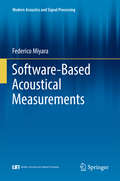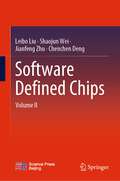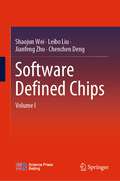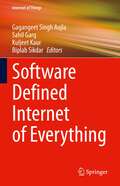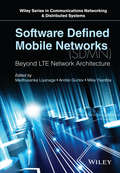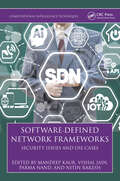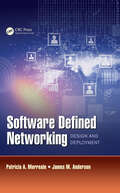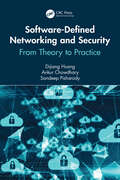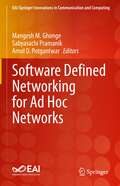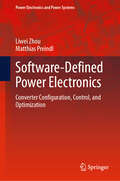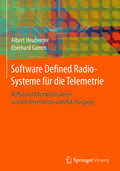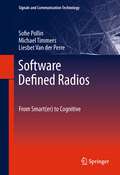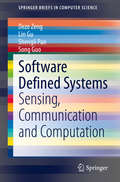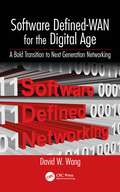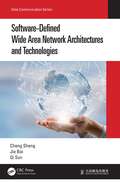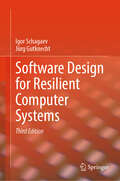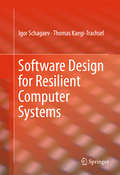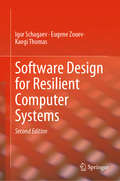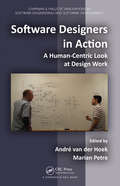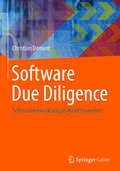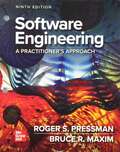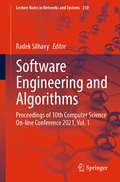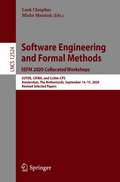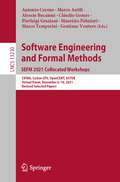- Table View
- List View
Software-Based Acoustical Measurements
by Federico MiyaraThis textbook provides a detailed introduction to the use of software in combination with simple and economical hardware (a sound level meter with calibrated AC output and a digital recording system) to obtain sophisticated measurements usually requiring expensive equipment. It emphasizes the use of free, open source, and multiplatform software. Many commercial acoustical measurement systems use software algorithms as an integral component; however the methods are not disclosed. This book enables the reader to develop useful algorithms and provides insight into the use of digital audio editing tools to document features in the signal. Topics covered include acoustical measurement principles, in-depth critical study of uncertainty applied to acoustical measurements, digital signal processing from the basics, and metrologically-oriented spectral and statistical analysis of signals. The student will gain a deep understanding of the use of software for measurement purposes; the ability to implement software-based measurement systems; familiarity with the hardware necessary to acquire and store signals; an appreciation for the key issue of long-term preservation of signals; and a full grasp of the often neglected issue of uncertainty in acoustical measurements. Pedagogical features include in-text worked-out examples, end-of-chapter problems, a glossary of metrology terms, and extensive appendices covering statistics, proofs, additional examples, file formats, and underlying theory.
Software Defined Chips: Volume II
by Leibo Liu Shaojun Wei Jianfeng Zhu Chenchen DengThis book is the second volume of a two-volume book set which introduces software-defined chips. In this book, the programming model of the software-defined chips is analyzed by tracing the coevolution of modern general-purpose processors and programming models. The enhancement in hardware security and reliability of the software-defined chips are described from the perspective of dynamic and partial reconfiguration. The challenges and prospective trends of software-defined chips are also discussed. Current applications in the fields of artificial intelligence, cryptography, 5G communications, etc., are presented in detail. Potential applications in the future, including post-quantum cryptography, evolutionary computing, etc., are also discussed. This book is suitable for scientists and researchers in the areas of electrical and electronic engineering and computer science. Postgraduate students, practitioners and professionals in related areas are also potentially interested in the topic of this book.
Software Defined Chips: Volume I
by Shaojun Wei Leibo Liu Jianfeng Zhu Chenchen DengThis is the first book of a two-volume book set which introduces software defined chips. In this book, it introduces the conceptual evolution of software defined chips from the development of integrated circuits and computing architectures. Technical principles, characteristics and key issues of software defined chips are systematically analyzed. The hardware architecture design methods are described involving architecture design primitives, hardware design spaces and agile design methods. From the perspective of the compilation system, the complete process from high-level language to configuration contexts is introduced in detail. This book is suitable for scientists and researchers in the areas of electrical and electronic engineering and computer science. Postgraduate students, practitioners and professionals in related areas are also potentially interested in the topic of this book.
Software Defined Internet of Everything (Internet of Things)
by Gagangeet Singh Aujla Sahil Garg Kuljeet Kaur Biplab SikdarThis book provides comprehensive discussion on key topics related to the usage and deployment of software defined networks (SDN) in Internet of Everything applications like, healthcare systems, data centers, edge/fog computing, vehicular networks, intelligent transportation systems, smart grids, smart cities and more. The authors provide diverse solutions to overcome challenges of conventional network binding in various Internet of Everything applications where there is need of an adaptive, agile, and flexible network backbone. The book showcases different deployment models, algorithms and implementations related to the usage of SDN in Internet of Everything applications along with the pros and cons of the same. Even more, this book provides deep insights into the architecture of software defined networking specifically about the layered architecture and different network planes, logical interfaces, and programmable operations. The need of network virtualization and the deployment models for network function virtualization is also included with an aim towards the design of interoperable network architectures by researchers in future. Uniquely, the authors find hands on practical implementation, deployment scenarios and use cases for various software defined networking architectures in Internet of Everything applications like healthcare networks, Internet of Things, intelligent transportation systems, smart grid, underwater acoustic networks and many more. In the end, design and research challenges, open issues, and future research directions are provided in this book for a wide range of readers
Software Defined Mobile Networks (SDMN)
by Andrei Gurtov Madhusanka Liyanage Mika YlianttilaThis book describes the concept of a Software Defined Mobile Network (SDMN), which will impact the network architecture of current LTE (3GPP) networks. SDN will also open up new opportunities for traffic, resource and mobility management, as well as impose new challenges on network security. Therefore, the book addresses the main affected areas such as traffic, resource and mobility management, virtualized traffics transportation, network management, network security and techno economic concepts. Moreover, a complete introduction to SDN and SDMN concepts. Furthermore, the reader will be introduced to cutting-edge knowledge in areas such as network virtualization, as well as SDN concepts relevant to next generation mobile networks. Finally, by the end of the book the reader will be familiar with the feasibility and opportunities of SDMN concepts, and will be able to evaluate the limits of performance and scalability of these new technologies while applying them to mobile broadband networks.
Software-Defined Network Frameworks: Security Issues and Use Cases (Computational Intelligence Techniques)
by Mandeep Kaur Vishal Jain Parma Nand Nitin RakeshSoftware-Defined Networks (SDN) work by virtualization of the network and the Cognitive Software-Defined Network (CSDN) combines the efficiencies of SDN with cognitive learning algorithms and enhanced protocols to automatize SDN. Partial deployment of SDN along with traditional networking devices forms a Hybrid Software-Defined Network (HSDN). Software-Defined Network Frameworks: Security Issues and Use Cases consolidates the research relating to the security in SDN, CSDN, and Hybrid SDNs. The security enhancements derived from the use of various SDN frameworks and the security challenges thus introduced, are also discussed. Overall, this book explains the different architectures of SDNs and the security challenges needed for implementing them.Features: Illustrates different frameworks of SDN and their security issues in a single volume Discusses design and assessment of efficient SDN northbound/southbound interfaces Describes cognitive computing, affective computing, machine learning, and other novel tools Illustrates coupling of SDN and traditional networking – Hybrid SDN Explores services, technologies, algorithms, and methods for data analysis in CSDN The book is aimed at researchers and graduate students in software engineering, network security, computer networks, high performance computing, communications engineering, and intelligent systems.
Software-Defined Networking: Extending SDN Control to Large-Scale Networks
by Fetia Bannour Sami Souihi Abdelhamid Mellouk<p>This book reviews the concept of Software-Defined Networking (SDN) by studying the SDN architecture. It provides a detailed analysis of state-of-the-art distributed SDN controller platforms by assessing their advantages and drawbacks and classifying them in novel ways according to various criteria.<p> <p>Additionally, a thorough examination of the major challenges of existing distributed SDN controllers is provided along with insights into emerging and future trends in that area.<p> <p>Decentralization challenges in large-scale networks are tackled using three novel approaches, applied to the SDN control plane presented in the book. The first approach addresses the SDN controller placement optimization problem in large-scale IoT-like networks by proposing novel scalability and reliability aware controller placement strategies. The second and third approaches tackle the knowledge sharing problem between the distributed controllers by suggesting adaptive multilevel consistency models following the concept of continuous Quorum-based consistency. These approaches have been validated using different SDN applications, developed from real-world SDN controllers.<p>
Software Defined Networking: Design and Deployment
by Patricia A. MorrealeSoftware Defined Networking: Design and Deployment provides a comprehensive treatment of software defined networking (SDN) suitable for new network managers and experienced network professionals. Presenting SDN in context with more familiar network services and challenges, this accessible text:Explains the importance of virtualization, particularly
Software-Defined Networking and Security: From Theory to Practice (Data-Enabled Engineering)
by Dijiang Huang Ankur Chowdhary Sandeep PisharodyThis book provides readers insights into cyber maneuvering or adaptive and intelligent cyber defense. It describes the required models and security supporting functions that enable the analysis of potential threats, detection of attacks, and implementation of countermeasures while expending attacker resources and preserving user experience. This book not only presents significant education-oriented content, but uses advanced content to reveal a blueprint for helping network security professionals design and implement a secure Software-Defined Infrastructure (SDI) for cloud networking environments. These solutions are a less intrusive alternative to security countermeasures taken at the host level and offer centralized control of the distributed network. The concepts, techniques, and strategies discussed in this book are ideal for students, educators, and security practitioners looking for a clear and concise text to avant-garde cyber security installations or simply to use as a reference. Hand-on labs and lecture slides are located at http://virtualnetworksecurity.thothlab.com/. Features Discusses virtual network security concepts Considers proactive security using moving target defense Reviews attack representation models based on attack graphs and attack trees Examines service function chaining in virtual networks with security considerations Recognizes machine learning and AI in network security
Software Defined Networking for Ad Hoc Networks (EAI/Springer Innovations in Communication and Computing)
by Sabyasachi Pramanik Mangesh M. Ghonge Amol D. PotgantwarThis book offers a comprehensive overview of Software-Defined Network (SDN) based ad-hoc network technologies and exploits recent developments in this domain, with a focus on emerging technologies in SDN based ad-hoc networks. The authors offer practical and innovative applications in Network Security, Smart Cities, e-health, and Intelligent Systems. This book also addresses several key issues in SDN energy-efficient systems, the Internet of Things, Big Data, Cloud Computing and Virtualization, Machine Learning, Deep Learning, and Cryptography. The book includes different ad hoc networks such as MANETs and VANETs, along with a focus on evaluating and comparing existing SDN-related research on various parameters. The book provides students, researchers, and practicing engineers with an expert guide to the fundamental concepts, challenges, architecture, applications, and state-of-the-art developments in the field.
Software-Defined Power Electronics: Converter Configuration, Control, and Optimization (Power Electronics and Power Systems)
by Liwei Zhou Matthias PreindlPower electronic devices and systems are attracting growing attention due to the electrification of energy conversion systems being a key factor in efforts to reduce fuel combustion and achieve carbon neutrality. This book provides a concept of software-defined power electronics architecture to generalize the power converter design and control procedures with various interfaced applications. The ultimate objective is to construct a reconfigurable software-defined power electronics architecture with standardized atomic power modules that can be leveraged for different electrified energy resources, such as electric vehicle charging, electric motor traction, solar power, and wind power. Several advanced control and design techniques are introduced in detail to achieve the proposed concept with a high-performance energy conversion system, including optimization-based control and estimation, variable frequency soft switching, and passive component design and optimization. The proposed generalized architecture also contributes to avoiding redundant hardware and algorithms design procedures. Software-Defined Power Electronics: Converter Configuration, Control, and Optimization is a guide for engineers and academic researchers to the highly specialized skills required for working in the fields of power converter design and development.
Software Defined Radio-Systeme für die Telemetrie: Aufbau und Funktionsweise von der Antenne bis zum Bit-Ausgang
by Albert Heuberger Eberhard GammDieses Buch behandelt alle für ein Software Defined Radio (SDR) relevanten Systemteile: Antenne, Antennenanpassung, analoges Frontend, A/D-Umsetzung, Digital Downconversion (DDC), Interpolation, Synchronisation, Demodulation. Zunächst werden die notwendigen Grundlagen für die Darstellung von Signalen vermittelt sowie der gesamte Aufbau eines Software Defined Radios beschrieben, um anschließend die einzelnen Komponenten näher zu betrachten.Der Schwerpunkt des Buches liegt auf dem Zusammenspiel der Komponenten und Signale innerhalb des Empfängers. Zur Veranschaulichung der Signale wird das Open-Source-Programm GNU Octave verwendet.
Software Defined Radios
by Michael Timmers Sofie Pollin Liesbet Van der PerreMany and ever more mobile users wish to enjoy a variety of multimedia services, in very diverse geographical environments. The growing number of communication options within and across wireless standards is accommodating the growing volume and heterogeneity in wireless wishes. On the other hand, advancement in radio technologies opening much more flexibility, a.o. through Software Defined Radios, opens up the possibility to realize mobile devices featuring multi-mode options at low cost and interesting form factors. It is crucial to manage the new degrees of freedom opened up in radios and standards in a smart way, such that the required service is offered at satisfactory quality as efficiently as possible. Efficiency in energy consumption is clearly primordial for battery powered mobile terminals specifically, and in the context of growing ecological concerns in a broader context. Moreover, efficient usage of the spectrum is a growing prerequisite for wireless systems, and coexistence of different standards puts overall throughput at risk. The management of flexibility risks bringing about intolerable complexity and hamper the desired agility. A systematic approach, consisting of anticipative preparing for smooth operation, allows mastering this challenge. Case studies show that already today, this approach enables smart operation of radios realizing impressive efficiency gains without hampering Quality-of-Service. In the future wireless communication scenes will be able to profit form the opening of the spectrum. Even smarter and cognitive behavior will become possible and essential.
Software Defined Systems: Sensing, Communication and Computation (SpringerBriefs in Computer Science)
by Deze Zeng Lin Gu Shengli Pan Song GuoThis book introduces the software defined system concept, architecture, and its enabling technologies such as software defined sensor networks (SDSN), software defined radio, cloud/fog radio access networks (C/F-RAN), software defined networking (SDN), network function virtualization (NFV), software defined storage, virtualization and docker. The authors also discuss the resource allocation and task scheduling in software defined system, mainly focusing on sensing, communication, networking and computation. Related case studies on SDSN, C/F-RAN, SDN, NFV are included in this book, and the authors discuss how these technologies cooperate with each other to enable cross resource management and task scheduling in software defined system. Novel resource allocation and task scheduling algorithms are introduced and evaluated. This book targets researchers, computer scientists and engineers who are interested in the information system softwarization technologies, resource allocation and optimization algorithm design, performance evaluation and analysis, next-generation communication and networking technologies, edge computing, cloud computing and IoT. Advanced level students studying these topics will benefit from this book as well.
Software Defined-WAN for the Digital Age: A Bold Transition to Next Generation Networking
by David W. WangSD-WAN is an advanced networking approach that creates hybrid networks to integrate broadband or other network services into the corporate WAN, not only just handling general business workloads and traffic, but also being capable of maintaining the performance and security of real-time and sensitive applications. This book posits that Software Defined (SD) WAN is the answer to questions such as what changes can be made to the networking sector? What innovations can make WAN, which plays a vital integrated part of the cloud ecosystem, more cost effective, performance robust, provisioning efficient, and operation intelligent?
Software-Defined Wide Area Network Architectures and Technologies (Data Communication Series)
by Cheng Sheng Jie Bai Qi SunStarting with problems and challenges faced by enterprise WANs, Software-Defined Wide Area Network Architectures and Technologies provides a detailed description of SD-WAN’s background and basic features, as well as the system architecture, operating mechanism, and application scenarios of the SD-WAN solution based on the implementation of Huawei SD-WAN Solution. It also explains key SD-WAN technologies and analyzes real SD-WAN deployment cases, affording readers with design methods and deployment suggestions for the SD-WAN solution. The information presented in this book is easy to understand and very practical. It enables you to become adept in the SD-WAN solution’s implementation and design principles. The book is intended for ICT practitioners, such as network technical support engineers, network administrators, and network planning engineers, to use in studying theory. Furthermore, it serves as reference material for network technology enthusiasts. Authors Cheng Sheng is the Chief Architect of Huawei’s SD-WAN Solution. He has nearly 20 years of experience in network product and solution design, as well as extensive expertise in product design and development, network planning and design, and network engineering project implementation. Jie Bai is an Architect of Huawei’s SD-WAN Solution. He is well versed in Huawei security products and SD-WAN Solution and has written books such as Huawei Firewall Technology Talk as well as Huawei Anti-DDoS Technology Talk. Qi Sun is a Senior Information Architect of Huawei, and he is knowledgeable in Huawei SD-WAN Solution, CloudVPN Solution, and Cloud Management Solution. He also participated in the information architecture design and delivery of multiple solutions.
Software Design for Resilient Computer Systems
by Igor Schagaev Jürg GutknechtThis book addresses the question of how system software should be designed to account for faults, and which fault tolerance features should provide for highest reliability. With this third edition of Software Design for Resilient Computer Systems, the book is thoroughly updated to contain the newest advice regarding software resilience. With a new introductory chapter, the new edition is ideal for researchers and industry professionals. In the book, the authors first show how system software interacts with the hardware to tolerate faults. They analyze and further develop the theory of fault tolerance to understand the diverse ways to increase the reliability of a system, with special attention on the role of system software in this process. They introduce the theory of redundancy and its use for construction of a subsystem through generalised algorithm of fault tolerance (GAFT) and apply it to distributed systems. The book’s approach is applied to various hardware subsystems: different structures of RAM and processor cores and demonstrates exceptional performance reliability and energy efficiency. This third edition devotes substantial attention to system software for modern computers, including run time systems, supporting algorithms of recovery and their analysis, language aspects and ways to improve reconfigurable and parallel computing. Due to the wide-reaching nature of the content, this book applies to a host of industries and research areas, including military, aviation, intensive health care, industrial control, and space exploration.
Software Design for Resilient Computer Systems
by Igor Schagaev Thomas Kaegi-TrachselThis book addresses the question of how system software should be designed to account for faults, and which fault tolerance features it should provide for highest reliability. The authors first show how the system software interacts with the hardware to tolerate faults. They analyze and further develop the theory of fault tolerance to understand the different ways to increase the reliability of a system, with special attention on the role of system software in this process. They further develop the general algorithm of fault tolerance (GAFT) with its three main processes: hardware checking, preparation for recovery, and the recovery procedure. For each of the three processes, they analyze the requirements and properties theoretically and give possible implementation scenarios and system software support required. Based on the theoretical results, the authors derive an Oberon-based programming language with direct support of the three processes of GAFT. In the last part of this book, they introduce a simulator, using it as a proof of concept implementation of a novel fault tolerant processor architecture (ERRIC) and its newly developed runtime system feature-wise and performance-wise. The content applies to industries such as military, aviation, intensive health care, industrial control, space exploration, etc.
Software Design for Resilient Computer Systems
by Igor Schagaev Eugene Zouev Kaegi ThomasThis book addresses the question of how system software should be designed to account for faults, and which fault tolerance features it should provide for highest reliability. With this second edition of Software Design for Resilient Computer Systems the book is thoroughly updated to contain the newest advice regarding software resilience. With additional chapters on computer system performance and system resilience, as well as online resources, the new edition is ideal for researchers and industry professionals.The authors first show how the system software interacts with the hardware to tolerate faults. They analyze and further develop the theory of fault tolerance to understand the different ways to increase the reliability of a system, with special attention on the role of system software in this process. They further develop the general algorithm of fault tolerance (GAFT) with its three main processes: hardware checking, preparation for recovery, and the recovery procedure. For each of the three processes, they analyze the requirements and properties theoretically and give possible implementation scenarios and system software support required. Based on the theoretical results, the authors derive an Oberon-based programming language with direct support of the three processes of GAFT. In the last part of this book, they introduce a simulator, using it as a proof of concept implementation of a novel fault tolerant processor architecture (ERRIC) and its newly developed runtime system feature-wise and performance-wise. Due to the wide reaching nature of the content, this book applies to a host of industries and research areas, including military, aviation, intensive health care, industrial control, and space exploration.
Software Designers in Action: A Human-Centric Look at Design Work
by André van der Hoek Marian PetreSoftware Designers in Action: A Human-Centric Look at Design Work examines how developers actually perform software design in their day-to-day work. The book offers a comprehensive look at early software design, exploring the work of professional designers from a range of different viewpoints. Divided into four sections, it discusses various theore
Software Due Diligence: Softwareentwicklung als Asset bewertet
by Christian DemantDieses praxisnahe Buch gibt einen Einblick in die Besonderheiten und vermeintlichen Geheimnisse der Softwareentwicklung. Dabei werden Methoden aufgezeigt, um die in der Softwareentwicklung versteckten Verm#65533;genswerte zu ermitteln und transparent zu machen. Software durchdringt immer mehr Bereiche in Industrie und Wirtschaft. IT-Management und Softwareentwicklung, die aktuell vielerorts noch als reine Unterst#65533;tzungs-Funktionen betrachtet werden, k#65533;nnten sich im Zuge der Digitalisierung in den n#65533;chsten Jahren in vielen Unternehmen zu Kernkompetenzen entwickeln. Um hierf#65533;r die aus unternehmerischer Sicht richtigen Weichenstellungen vornehmen zu k#65533;nnen, ist eine Positionsbestimmung die Voraussetzung. Die Zielgruppen Das Buch richtet sich an Wirtschaftspr#65533;fer, Steuerberater, Investoren, Business-Angels, M&A-Verantwortliche bei Banken sowie Inhaber und Gesch#65533;ftsf#65533;hrer von Softwareunternehmen oder Unternehmen, in denen die Softwareentwicklung einen wesentlichen Beitrag zur Wertsch#65533;pfung liefert.
Software Engineering: A Practitioner's Approach
by Bruce R. Maxim Roger S. PressmanFor almost four decades, Software Engineering: A Practitioner's Approach (SEPA) has been the world's leading textbook in software engineering. The ninth edition represents a major restructuring and update of previous editions, solidifying the book's position as the most comprehensive guide to this important subject.
Software Engineering and Algorithms: Proceedings of 10th Computer Science On-line Conference 2021, Vol. 1 (Lecture Notes in Networks and Systems #230)
by Radek SilhavyThis book constitutes the refereed proceedings of the Software Engineering and Algorithms section of the 10th Computer Science On-line Conference 2021 (CSOC 2021), held on-line in April 2021. Software engineering research and its applications to intelligent algorithms take an essential role in computer science research. In this book, modern research methods, application of machine and statistical learning in the software engineering research are presented.
Software Engineering and Formal Methods. SEFM 2020 Collocated Workshops: ASYDE, CIFMA, and CoSim-CPS, Amsterdam, The Netherlands, September 14–15, 2020, Revised Selected Papers (Lecture Notes in Computer Science #12524)
by Loek Cleophas Mieke MassinkThis volume constitutes the revised selected papers from the three workshops collocated with the 18th International Conference on Software Engineering and Formal Methods, SEFM 2020, held in Amsterdam, The Netherlands, in September 2020. The 15 full papers presented together with 8 short papers in this volume were carefully reviewed and selected from a total of 35 submissions. The contributions that are collected in this volume have been selected from the presentations at the following workshops: ASYDE 2020: Second International Workshop on Automated and Verifiable Software System Development; CIFMA 2020: Second International Workshop on Cognition: Interdisciplinary Foundations, Models and Applications; and CoSim-CPS 2020: Fourth International Workshop on Formal Co-Simulation of Cyber-Physical Systems. Due to the Corona pandemic this event was held virtually.
Software Engineering and Formal Methods. SEFM 2021 Collocated Workshops: CIFMA, CoSim-CPS, OpenCERT, ASYDE, Virtual Event, December 6–10, 2021, Revised Selected Papers (Lecture Notes in Computer Science #13230)
by Antonio Cerone Marco Autili Alessio Bucaioni Cláudio Gomes Pierluigi Graziani Maurizio Palmieri Marco Temperini Gentiane VentureThis volume constitutes revised selected papers from the four workshops collocated with the 19th International Conference on Software Engineering and Formal Methods, SEFM 2021, held virtually during December 6–10, 2021.The 21 contributed papers presented in this volume were carefully reviewed and selected from a total of 29 submissions. The book also contains 3 invited talks.SEFM 2021 presents the following four workshops:CIFMA 2021 - 3rd International Workshop on Cognition: Interdisciplinary Foundations, Models and Applications;CoSim-CPS 2021 - 5th Workshop on Formal Co-Simulation of Cyber-Physical Systems;OpenCERT 2021 - 10th International Workshop on Open Community approaches to Education, Research and Technology;ASYDE 2021 - 3rd International Workshop on Automated and verifiable Software sYstem Development.Due to the Corona pandemic this event was held virtually.
